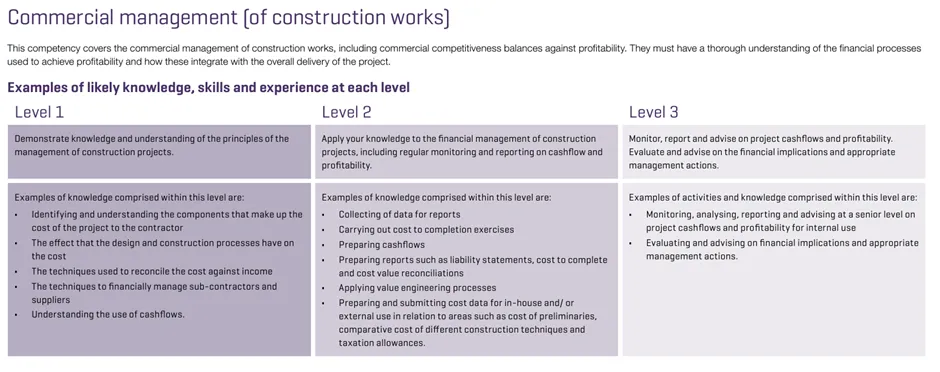
RICS APC: Commercial Management (of Commercial Works)
As the mid-September 2024 submission window for RICS APC candidates sitting in 2024 Session Two is nearly upon us, we wanted to do a mini-series focused on technical competencies within the RICS APC Quantity Surveying and Construction pathway guide.
We will do this by writing a five-minute article on each of the six core technical competencies which form part of the pathway requirements for quantity surveyors. The intention is to give you some things to think about as you ready your experience record for submission and prepare for the assessment interview. Whilst the article is RICS APC focused, the content will still be relevant to any construction professional looking to advance or refresh their knowledge in this area.
This week’s focus is commercial management (of construction works) which is the core technical competency often selected by contractor QS’s (with design economics and cost planning often selected by our PQS colleagues).
The Definition
Commercial management (of construction works) is defined as ‘the commercial management of construction works, including commercial competitiveness balances against profitability. They must have a thorough understanding of the financial processes used to achieve profitability and how these integrate with the overall delivery of the project’.
A snapshot of the competency description from the pathway guide is provided at Figure 1, where you will see what is required of you at level 1, level 2 and level 3.

Figure 1
At your APC assessment, you need to demonstrate that you have achieved level 3 competency. Remember: level 3 is advising; level 2 is doing; and level 1 is knowing. What constitutes advice? The Oxford English Dictionary defines advice as “guidance or recommendations offered with regard to prudent future action”.
For me, in the context of the APC, this means there was an issue, and you used your professional judgement to understand the issue and recommend to your client or your employer as to the action which should be taken.
Let’s explore this further with some hypothetical examples of commercial management (of construction works).
Level 3, Bullet 1
At level 3, you are required to demonstrate that you can competently ‘monitor, analyse, report and advise at a senior level on project cashflows and profitability for internal use’.
For most contractor QS’s, you will give that advice in monthly project review / CVR type meetings. In those meetings, you discuss with senior management a financial snapshot of the project taking account of the issues which have occurred in the reporting period.
An example might be the project falling behind programme. When this occurs, your forecast costs will increase, and you might be exposed to delay damages (i.e. there will be a profitability and a cashflow impact). It is unlikely there will be budget for those costs, so you have three options: recover through the contract, utilise risk contingency, or reduce the margin position.
Your advice will depend upon who is liable for the delay to the project programme. If it was caused by a risk which was retained by the client, then you would recommend one set of actions, however it was caused by a risk which was retained by your business then you would recommend a different set of actions.
Another example would be where supply chain tenders are received, and the tender prices are higher than your budget. You would raise this in your project review and give advice on the appropriate course of action. The options would be placing the order at a loss (and utilising contingency or margin), incur more programme time by going back out to tender, or some other option that might be available.
Level 3, Bullet 2
At level 3, you are required to demonstrate that you can competently ‘evaluate and advise on financial implications and appropriate management actions.’
There is possibly some overlap with bullet 1 in that some examples could be said to fall within each of the bullets. For the purposes of this article, I will distinguish between the two and give you some examples of forward-looking profitability and cashflow issues where an exploratory conversation is required to inform decision making.
An example of this would be considering whether to change your delivery strategy from directly employed labour to sub-contract labour. In this decision-making process you would need to evaluate and advise on the profitability and cashflow impact so that decision makers are fully informed.
Another example might be concerns about the financial viability of a subcontractor. This risk would need to be managed, however decision making needs to be considered and thought through. You would give advice to a decision maker on the options available and how these options might impact profitability or cashflow. The decision might be to do nothing but at least that decision has been consciously made, with all the available information made available.
Final Reflections
In both bullet points, profitability and cashflow are key and you need to understand the core of the issue so that you can consider the risk and give advice on the impact to profitability and cashflow. In most cases when giving advice, there is a downside no matter which option you take, and you are looking to make the best decision with the information available.
That’s the professional judgement which an assessor would look for you to demonstrate in your experience record submission and in the assessment interview. Can you look at these options from multiple perspectives (programme, design etc) to give sound and reasoned advice? If so, show that you can do it.
In next week’s article, we will look at construction and technology and environmental services. Keep an eye out for that and, in the meantime, enjoy the rest of your week!
Bringing The science of Quantik® to you
p.s. If anything in this article, or any of our articles, resonates with a challenge you are experiencing, check out our ‘Bringing The science of Quantik® to you’ initiative where we offer a tailor-made session aimed at helping you tackle your project or business challenge (link below).
Form: https://form.jotform.com/241425931072350
Back to articles
THE SCIENCE OF QUANTIK™
Publications
We publish insights through our LinkedIn newsletter, titled “The science of Quantik”, which are light bites of information covering news and insights relating to the construction industry and quantity surveying.
LinkedIn